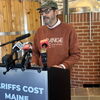Processing Your Payment
Please do not leave this page until complete. This can take a few moments.
- News
-
Editions
-
- Lists
-
Viewpoints
-
Our Events
-
Event Info
- Women's Leadership Forum 2025
- On the Road with Mainebiz in Bethel
- Health Care Forum 2025
- On The Road with Mainebiz in Greenville
- On The Road with Mainebiz in Waterville
- Small Business Forum 2025
- Outstanding Women in Business Reception 2025
- On The Road with Mainebiz in Bath
- 60 Ideas in 60 Minutes Portland 2025
- 40 Under 40 Awards Reception 2025
- On The Road with Mainebiz in Lewiston / Auburn
- 60 Ideas in 60 Minutes Bangor 2025
Award Honorees
- 2025 Business Leaders of the Year
- 2024 Women to Watch Honorees
- 2024 Business Leaders of the Year
- 2023 NextUp: 40 Under 40 Honorees
- 2023 Women to Watch Honorees
- 2023 Business Leaders of the Year
- 2022 NextUp: 40 Under 40 Honorees
- 2022 Women to Watch Honorees
- 2022 Business Leaders of the Year
-
-
Calendar
-
Biz Marketplace
- News
- Editions
- Lists
- Viewpoints
-
Our Events
Event Info
- View all Events
- Women's Leadership Forum 2025
- On the Road with Mainebiz in Bethel
- Health Care Forum 2025
- On The Road with Mainebiz in Greenville
- On The Road with Mainebiz in Waterville
- + More
Award Honorees
- 2025 Business Leaders of the Year
- 2024 Women to Watch Honorees
- 2024 Business Leaders of the Year
- 2023 NextUp: 40 Under 40 Honorees
- 2023 Women to Watch Honorees
- 2023 Business Leaders of the Year
- + More
- 2022 NextUp: 40 Under 40 Honorees
- 2022 Women to Watch Honorees
- 2022 Business Leaders of the Year
- Nomination Forms
- Calendar
- Biz Marketplace
UMaine’s nanocellulose research draws interest from artists, too
 Courtesy / University of Maine
Alex Rose, a graduate student in intermedia studies, experiments with nanocellulose in her art.
Courtesy / University of Maine
Alex Rose, a graduate student in intermedia studies, experiments with nanocellulose in her art.
Nanocellulose is all the buzz at the University of Maine as a potential breakthrough material for industries such as manufacturing, home construction and boatbuilding.
Now “intermedia” students are creating art with nanocellulose, which is produced from wood fibers.
“We hope that one day soon Maine will be providing this material to artists all around the world,” Colleen Walker, director of the university’s Process Development Center, said in a news release.
The university’s Advanced Structures and Composites Center has been working for nearly 20 years on the development of nanocellulose, which is well-suited for 3D printing of large, structurally demanding products.
The center is a leader in cellulose nano fiber, derived from Maine’s forest industry, and its use in combination with thermoplastic composites. Cellulose nano fiber is cellulose that has been broken down to a scale of nanometers, or billionths of a meter. Placing cellulose nano fiber into plastics results in strong, stiff and recyclable bio-derived material that becomes filament for 3D printing.
It’s thought that nanocellulose can be part of material systems with properties that may rival traditional materials, possibly even metals.
In a mixture that is 97% water, nanocellulose looks like yogurt or paste. When freeze-dried, it has the consistency of Styrofoam. Fully dried, it's like a plastic tile.
Walker said artists began calling her lab asking if they could buy nanocellulose.
Because of its production capabilities, the center is one of the only ones in the world that distributes nanocellulose by the pound, usually at a rate of $75 for a pound’s worth in a five-gallon bucket.
Even the center’s research manager, Donna Johnson, had experimented with the material in her own artistic pursuits in jewelry, fabric art and dyes.
Then a graduate student with the university’s intermedia studies program, Augusta Sparks Farnum, arrived at the center looking for nanocellulose to use in her assignments.
Farnum said she felt jaded about the art world’s lack of sustainable art materials and practices. She intrigued by nanocellulose as a biodegradable, nontoxic material.
“I could make something and if it didn’t work and instead of hauling it around for the rest of my life I could put it back in the forest and it would decompose,” Farnum said. “Coming from the art world, that’s not true of most things. You’re dealing with plastics and chemicals.”
Walker started asking questions about using nanocellulose in art and how the center could partner with the intermedia program.
Susan Smith, director of the intermedia program, formalized the partnership between the program and the center. The center donated buckets of nanocellulose to the artists.
“The idea of possibility was really what attracted us, as well as the fact that it was a brand new material,” said Smith. “Artists naturally want to play with materials and experiment.”
Smith said experimentation with the material suits the program’s mission to pursue “research-based art.”
“This provides a possibility for art that is sustainable, but also local,” Smith said. “Our dependence on unsustainable processes must change, and with this research, we are able to support the Process Development Center research, but also think in terms of innovations with our own processes.”
The center donated buckets of nanocellulose to the artists.
Smith said she uses it as a nontoxic binder for natural pigment for her printmaking, which is preferable to those that are petroleum-based or made of acrylic polymers.
Farnum experiments with cellulose armatures. She applied paint as well as silver, gold and aluminum leaf. She has been adding a bioproduct of seaweed to the nanocellulose, which helps catch the light.
“If you look at it closely, the nanocellulose looks like skin or bone,” Farnum said. “I am still in the experimenting stage.”
Alex Rose, another intermedia graduate student, has been using nanocellulose as a coating for textiles and fibers. The dried nanocellulose gives recycled T-shirt strips a sense of gravity, and makes naturally dyed material look foggy and contorts it into a crispy wafer.
“It’s really interesting because it’s very mysterious in how the end product will be,” Rose said. “It feels like a discovery every time you try something new.”
The artists have learned things about nanocellulose to share with the researchers, too. For example, although nanocellulose itself doesn’t get moldy on its own, if it is contaminated in any way, mold can grow.
“This collaboration is an excellent way to broaden the research community working with this unique material,” said Walker.














0 Comments